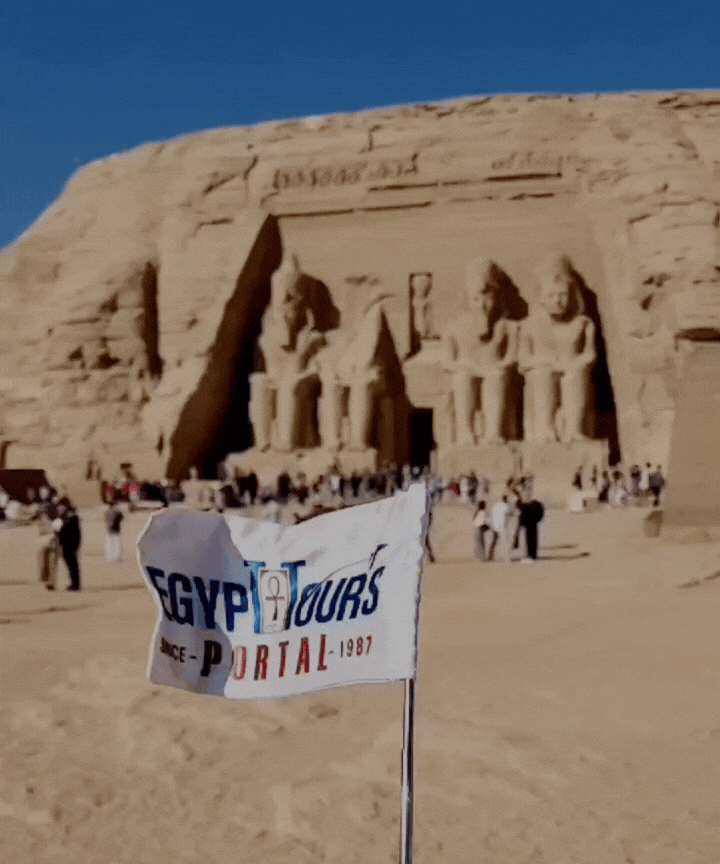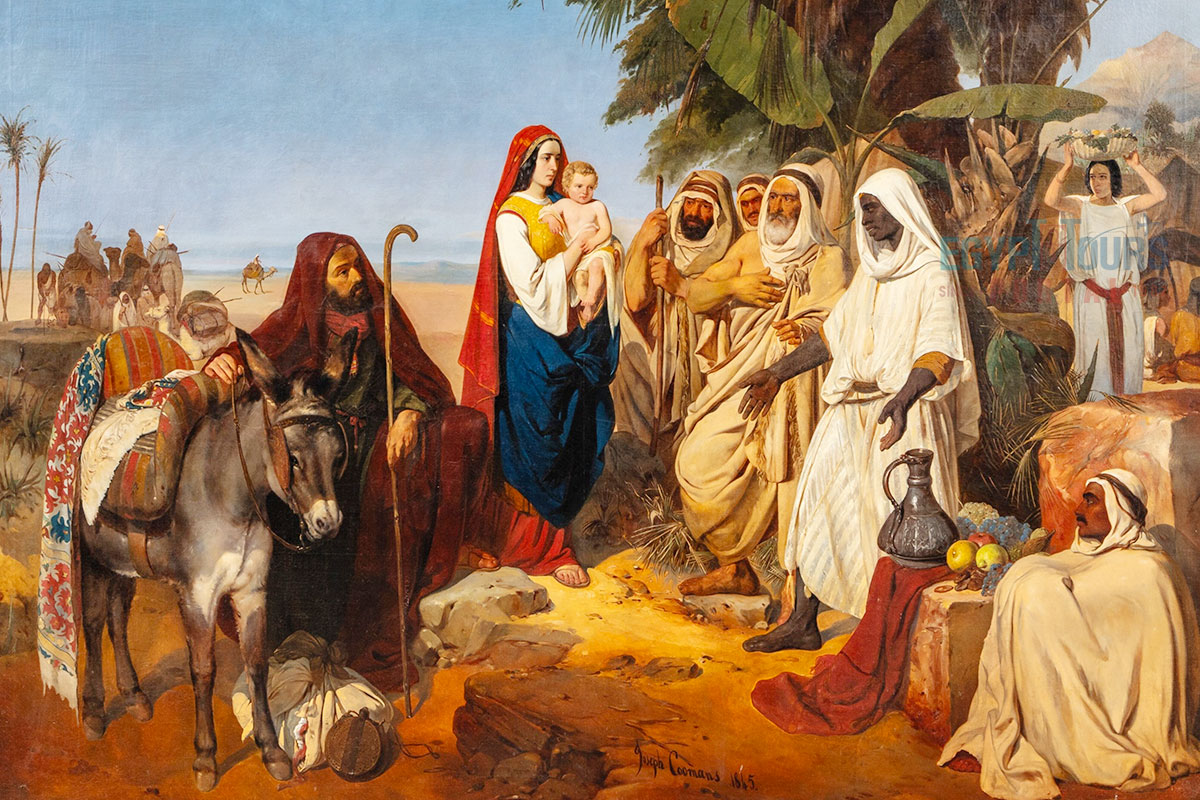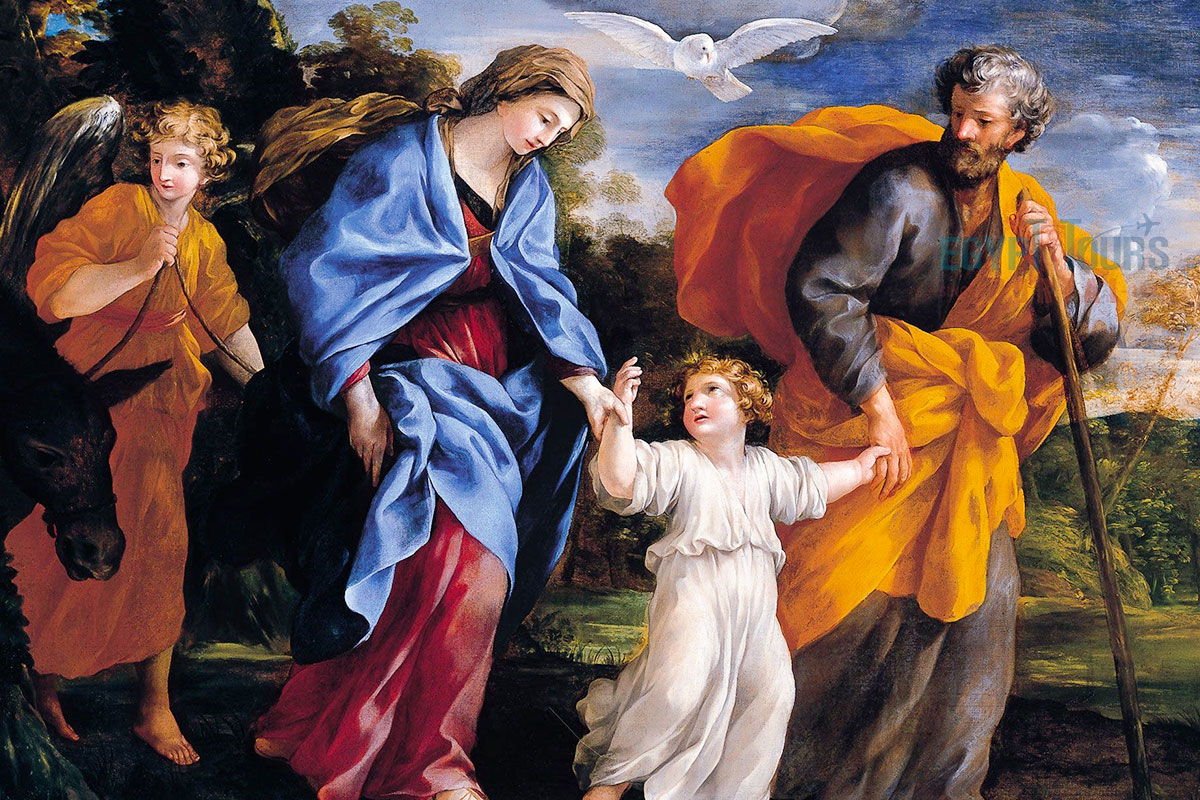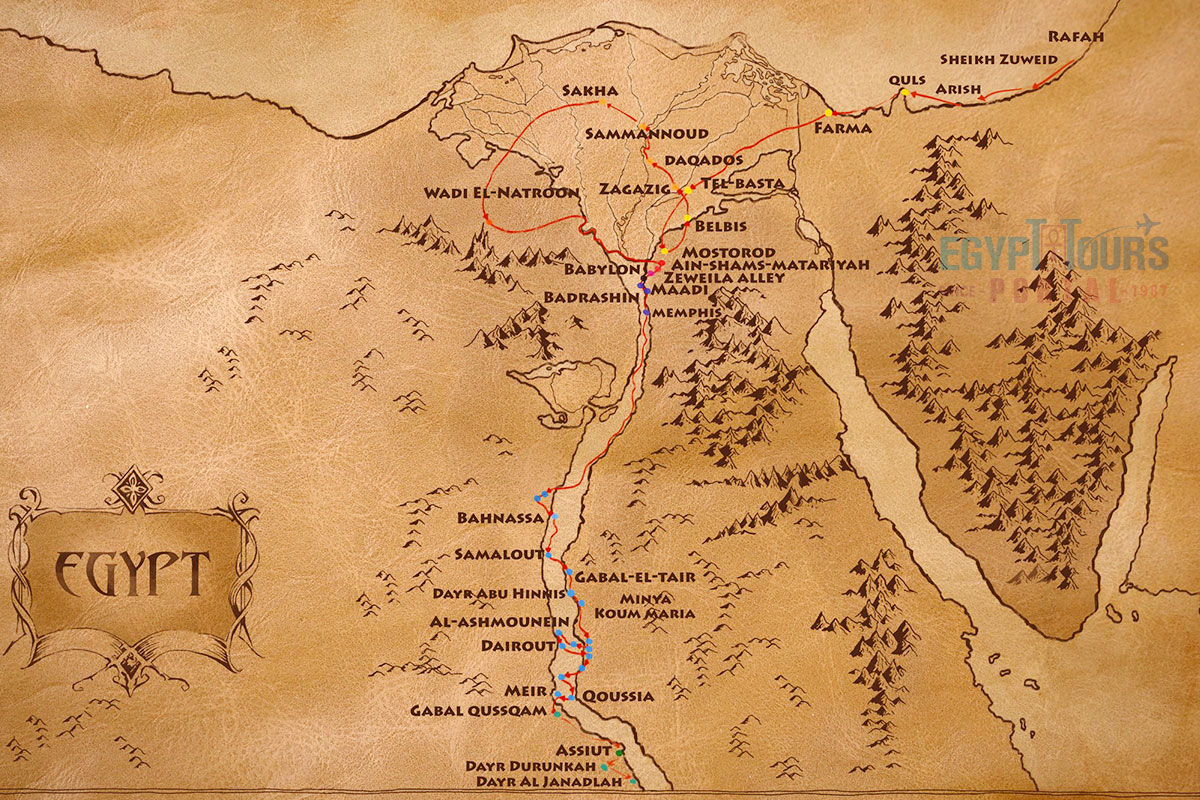The Holy Family’s journey through Egypt is a deeply sacred chapter in Christian history. Escaping King Herod, Jesus, Mary, and Joseph traveled through 26 holy sites, performing miracles that turned Egypt into a cornerstone of early Christianity. Their path, marked by divine blessings like healing springs and blooming trees, is commemorated each year on June 1st by the Coptic Church as a lasting symbol of faith, refuge, and spiritual legacy.


The Holy Family in Egypt was on a sacred journey by an order from God to spread his message until the time of salvation. This article's main purpose is to offer every traveler all the information and facts about the holy family in Egypt. This article was written by a group of a very skilled and experienced team of tour guides, experts, and scholars who know all the facts and history about the holy family in Egypt.
This article offers the answers to a number of important questions, like Did Jesus ever live in Egypt, Where did Jesus go in Egypt, and many other important questions. Learn about one of the most important stories ever told in the history of mankind.

The legendary divine story of the holy family took place more than 2000 years ago when a group of wise men declared that Jesus is a prophet from God and the next king of the jews. That's why the ruler of Judea, King Herod, decided to end his life. The holy family escaped from Bethlehem to Egypt, where Herod had no political power, after Joseph was warned by an angel to leave the land with Jesus and the Virgin Mary.
They began their journey from northern Sinia until they reached Farama. The places in which the holy family stayed have been chosen to build churches and monasteries. The holy family then headed to Tel Basta when Jesus blessed the land, which caused a water spring to explode from the ground. The next stop was Mostorod, also known as el Mahamaah, which means the bathing place. The town was given a name where the Virgin Mary bathed in child Jesus and washed his clothes.
They then headed to Belbeis, where they sat under the shadow of a sycamore tree, which was known as the Virgin Mary's Tree. When the holy family crossed the Nile to the city of Samanoud, Jesus, while in Sakha, touched the stone, and then water started to thrust out from it. The holy family then made their way all the way to the Valley of Natroun in the west of Egypt. The Natroun valley is well known as monasticism’s first home on earth to practice chastity and meditate on God.
The holy family then finally made their way to Cairo's districts of Matariyah and Ain Shams, where Jesus made blessed water well. When the Virgin Mary washed Jesus' clothes and then poured the water on the ground, a balsam tree blossomed, which was used for the preparation of the holy Myron.
The Holy Family entered old Cairo, then took refuge in a cave which became the church of Abu Serja, which is located within the walls of the fortress of Babylon. This whole entire area became a center of pilgrimage for people from all over the world. They then moved to Al Maadi, where the church of the Virgin Mary was constructed across the Nile. The family then boarded a boat and sailed southward along the Nile.
The Holy family made their way to Minya, where they crossed the east bank of the Nile and landed on a spot where the monastery of the Virgin was constructed on top of Gabal Al-Kaf, "Mountain of the Palm," where Jesus left an immortal blessed imprint on a stone found in the mountain.
From this place, the family crossed the Nile from the west to the city of Qussqam in Assiut where they stayed for six months which is longer than any other place that stayed in during their time in Egypt plus in the same spot a monastery of Al Moharraq was built when an angel appeared in Joseph's dream telling him that Herod was dead and that they should return to Palestine. The Holy family then took the same journey back to Palestine after spending three years in Egypt.

The Holy Family found Egypt to be a place of refuge and security, making it their shelter as they journeyed southward across the land. Along their path, they visited numerous sacred sites, including the Fortress of Babylon in Old Cairo, one of the most historic and spiritually significant locations in the region. From there, they traveled further to behold the iconic pyramids of Giza.
Tradition holds that there once stood a palm tree at Giza beneath which the Blessed Virgin Mary nursed the infant Jesus, providing him comfort and respite. Each of these locations has since become an emblem of their journey, celebrated and remembered by generations.

The Holy Family sought refuge in Egypt to escape the threat of King Herod, who, in his fear of the prophecy concerning the "King of the Jews," posed a severe danger to the child Jesus. Egypt, beyond Herod’s political influence, was a haven where he could not wield any power, ensuring that he could not harm the Holy Child.
Upon their arrival, however, they faced further challenges, as Herod’s spies attempted to trace their steps. Consequently, the Holy Family moved frequently, traveling across numerous towns and villages in Egypt to evade these agents, creating a trail that is still revered by followers today.

After an arduous journey of 65 kilometers from Palestine, the Holy Family found sanctuary in Egypt, where they remained for approximately three years. Their return was only possible after King Herod died in 4 B.C., when Joseph received divine guidance in a dream, instructing him that it was now safe to go back to Israel.
The family then embarked on the journey back to Nazareth, covering a distance of at least 170 kilometers. Their return to Nazareth marked the end of a defining chapter of their lives spent in the land of Egypt.

The Holy Family spent approximately three and a half years journeying through Egypt. During this period, they crossed 26 significant locations throughout the country, each place symbolizing a unique part of their search for refuge.
Their journey began in northern Sinai, where they initially entered Egypt. For the entirety of their stay, the Holy Family continued to relocate frequently, seeking new safe havens across the Egyptian landscape to avoid the reach of Herod’s spies. These locations remain venerated sites, embodying the Holy Family's resilient quest for safety and peace.

The journey of the Holy Family through Egypt is a profound chapter in Christian history, with each site along their route holding historical and spiritual significance. Their path is believed to have spanned various towns and regions, each marked by events now venerated by Coptic Christians and visitors alike. These towns include the following:
Explore the marvelous churches and monasteries of Egypt
Read MoreThe Holy Family’s entry into Egypt began in the ancient city of Farama, also known as Pelusium, near the northeastern border. This city, located along the Mediterranean coast, was significant even before its arrival and later became a prominent Christian site. It is home to several churches, including one that dates back to the first century after the introduction of Christianity by St. Mark. Today, visitors can find remnants of churches and monasteries from both ancient and modern times.
Located just north of Cairo, Mostorod, also known as El Mahamaah, meaning “The Bathing Place,” was the next stop. Here, the Virgin Mary is said to have bathed the infant Jesus and washed his clothes. This location is revered, and many believe a spring miraculously welled up, providing water for the family. The site remains a significant pilgrimage destination, symbolizing comfort and sustenance.
The family then traveled to Tel Basta, a town near Mostorod. According to tradition, Jesus blessed the land upon their arrival, causing a spring to miraculously rise from the ground. This act of blessing the earth is believed to symbolize renewal, and Tel Basta became a sacred stop on the Holy Family’s journey, commemorated with churches and monuments over the centuries.
Moving northeastward, they reached Belbeis in the Sharqiah Governorate, where they sought shade under a sycamore tree. This tree, later known as the "Virgin Mary's Tree," became an iconic symbol of shelter and peace for travelers and pilgrims alike. The location is honored today for the family’s brief respite under its branches.
After crossing the Nile, the family arrived in Samanoud, where they were warmly welcomed by the local population. In this Delta city, relics are preserved, such as a large granite trough said to have been used by the Virgin Mary to knead bread, and a well from which Jesus is believed to have drawn water.
The journey continued to Sakha, known by the Copts as "Peka-Issous," meaning "The Foot of Jesus." Here, a rock bearing an impression of the child Jesus' footprint was discovered, preserved by the local community for centuries as a testament to their passage through the area. This relic is a central symbol of the Holy Family’s journey in Sakha.
In Wadi El Natroun, a desert valley, the Holy Family found respite in a remote, barren area that would later become a monastic hub. This region, now home to some of the oldest Christian monasteries in Egypt, preserves Coptic art and culture dating back to early Christianity. The monasteries established here were inspired by the family’s brief stay, serving as sites for devotion and seclusion.
From the desert, they journeyed to the Cairo districts of Matariyah and Ain Shams. According to tradition, a balsam plant bloomed where Mary washed Jesus’ clothes, and a spring was blessed by the child Jesus himself. The ancient "Mary's Tree" still stands here, a symbol of refuge and blessed growth, while the area of Ain Shams was notable for its Jewish community and synagogue at the time.
Entering Old Cairo, or Misr Al-Qadima, the family reached the historical Babylon Fortress. The Holy Family’s time here is marked by the famous Abu Serga Church, built upon a cave where they took shelter. The Hanging Church, another revered landmark, commemorates their presence and is a central site for Christian pilgrims today.
Continuing south, the family reached Maadi, a site linked with their departure towards Upper Egypt. At the docking point, the Virgin Mary Church now stands as a tribute to the spot where they boarded a boat to continue their journey up the Nile river. A set of ancient steps leading to the Nile bank, believed to have been used by the Holy Family, remains accessible to visitors today.
Traveling further south, they arrived in Minya. On the east bank of the Nile lies Gabal Al-Kaf, where local tradition holds that a laurel tree bowed in reverence as the Holy Family passed by. The site, known as El Abed or "The Worshipper," is symbolic of nature’s homage to the child Jesus.
In Assiut, the Holy Family spent a significant time at Gebel Qussqam, staying in this area for over six months. The Monastery of Al-Moharraq was later constructed here, marking their longest stay in Egypt. A cave where they resided became the altar of the Virgin Mary Church within the monastery. It was in this sacred spot that an angel is said to have appeared to Joseph, instructing him to return to Palestine as Herod had died.
Upon receiving divine guidance, the Holy Family retraced a portion of their original path back towards Palestine, moving through Old Cairo and Matariyah once again before crossing the Sinai desert. Their journey, filled with hardship and faith, left an indelible mark on Egypt, turning each stop into a site of reverence and remembrance.
It is celebrated on June 1st (24 Pashons on the Coptic calendar). This feast is one of the Seven Minor Feasts of the Lord in the Coptic Orthodox Church, commemorating the Holy Family’s arrival in Egypt as a refuge from King Herod. This event symbolizes Egypt’s integral role in early Christianity and the enduring spiritual connection between the Holy Family’s journey and the faith of Coptic Christians.
The celebration also emphasizes the importance of following Jesus' example of seeking refuge from sin, along with His mission to dismantle paganism in Egypt, paving the way for a spiritual sanctuary and establishing a church in Egypt.
The Gospel of Matthew underscores the bond between Jesus, Mary, Joseph, and Egypt, highlighting Egypt as a place of protection from Herod’s massacre of infants. In Matthew 2:13-15, Joseph receives a divine warning to take his family to Egypt, fulfilling a prophecy that parallels Jesus’ journey with the Exodus of Israel, both leaving Egypt under God’s guidance.
The Holy Family’s departure from Egypt after Herod’s death, as described in Matthew 2:19-21, further emphasizes Egypt’s unique role in Jesus’ early life and the divine purpose linked to His time there. This biblical narrative enhances Egypt’s foundational role in the history of Christianity.
Many churches and monasteries were built along their trail, and many spiritualists, explorers, and travelers were taken by the holy family's journey as a highly popular draw. Check and book one of our Egypt vacations and a magical Nile River cruise to visit the most famous churches in Egypt.
Amazing Coptic Cairo Day Tour for American Travelers Our Coptic Cairo day tour will ...
Tour Location: Old Cairo...
Best 6 Days Pyramids & Coptic Cairo in Depth for American Travelers 6 Days Pyram...
Tour Location: Cairo/Giza/Zeitoun/Most...
Amazing 11 Days Adventure Tour to the Holy Family in Egypt for American Travelers 11...
Tour Location: Cairo/Alexandria/Zeitou...
13 Days of Nature Discovery in Egypt for American Travelers 13 Days Egypt tour between Garde...
Tour Location: Giza - Cairo - Sinai - F...
The journey from Bethlehem to Egypt, historically significant as the route taken by the Holy Family fleeing King Herod, spans approximately 692 kilometers (430 miles) in a straight line. However, the actual road distance varies from 730 to 800 kilometers (453 to 497 miles), typically taking around 10 to 12 hours by car, though border crossings and traffic can add time. The most common driving route passes through Israel, near Jerusalem, and continues to Egypt’s border by Rafah or Taba.
For faster travel, many opt for flights from Ben Gurion Airport in Tel Aviv or from Amman, Jordan, to Cairo, reducing travel time to 1–2 hours. This journey’s historical importance is celebrated in Christian tradition, marking the path Joseph, Mary, and Jesus undertook through challenging desert terrain. This route remains a meaningful pilgrimage route today, offering insight into the rich cultural and historical depth of the region.
The entire country of Egypt deserve to be explored with its every heavenly detail but there are places that must be seen before any other such as the breathtaking Hurghada's red sea, The wonders of Cairo the pyramids of Giza, the great sphinx, the Egyptian Museum, Khan El Khalili Bazaar, the wonders of Luxor like Valley of the Kings, Karnak & Hatshepsut temple and the wonders of Aswan such as Abu Simbel temples, Philea temple, Unfinished obelisk and The Wonders of Alexandria like Qaitbat Citadel, Pompey's Pillar and Alexandria Library. Read more about the best places to visit in Egypt.
If you want to apply for a Visa On Arrival that lasts for 30 days then you should be one of the eligible countries, have a valid passport with at least 6 months remaining and pay 25$ USD in cash, as for the E-Visa for 30 day you should have a valid passport for at least 8 months, complete the online application, pay the e-visa fee then print the e-visa to later be presented to the airport border guard. You could also be one of the lucky ones who can obtain a free visa for 90 days. Read more about Egypt travel visa.
Egypt has a variety of delicious cuisines but we recommend “Ful & Ta’meya (Fava Beans and Falafel)”, Mulukhiya, “Koshary”, a traditional Egyptian pasta dish, and Kebab & Kofta, the Egyptian traditional meat dish.
The best time to travel to Egypt is during the winter from September to April as the climate becomes a little tropical accompanied by a magical atmosphere of warm weather with a winter breeze. You will be notified in the week of your trip if the Climate is unsafe and if any changes have been made.
You should pack everything you could ever need in a small bag so you could move easily between your destinations.
We have been creating the finest vacations for more than 20 years around the most majestic destinations in Egypt. Our staff consists of the best operators, guides and drivers who dedicate all of their time & effort to make you have the perfect vacation. All of our tours are customized by Travel, Financial & Time consultants to fit your every possible need during your vacation. It doesn't go without saying that your safety and comfort are our main priority and all of our resources will be directed to provide the finest atmosphere until you return home.
You will feel safe in Egypt as the current atmosphere of the country is quite peaceful after the government took powerful measures like restructuring the entire tourist police to include all the important and tourist attractions in Egypt. Read more about is it safe to travel to Egypt.
Wear whatever feels right and comfortable. It is advised to wear something light and comfortable footwear like a closed-toe shoe to sustain the terrain of Egypt. Put on sun block during your time in Egypt in the summer to protect yourself from the sun.
The best activity is by far boarding a Nile Cruise between Luxor and Aswan or Vise Versa. Witness the beauty of Egypt from a hot balloon or a plane and try all the delicious Egyptian cuisines and drinks plus shopping in old Cairo. Explore the allure and wonders of the red sea in the magical city resorts of Egypt like Hurghada and many more by diving and snorkeling in the marine life or Hurghada. Behold the mesmerizing western desert by a safari trip under the heavenly Egyptian skies.
There are a lot of public holidays in Egypt too many to count either religious or nation, the most important festivals are the holy month of Ramadan which ends with Eid Al Fitr, Christmas and new years eve. Read more about festivals & publich holidays in Egypt.
Egypt is considered to be one of the most liberal Islamic countries but it has become a little bit conservative in the last couple of decades so it is advised to avoid showing your chest, shoulders or legs below the knees.
Arabic is the official language and Most Egyptians, who live in the cities, speak or understand English or at least some English words or phrases. Fewer Egyptians can speak French, Italian, Spanish, and German. Professional tour guides, who work in the tourism sector, are equipped to handle visitors who cannot speak Arabic and they will speak enough English and other languages to fulfill the needs of all our clients.
The fastest way is a car, of course, a taxi. If you are in Cairo ride a white taxi to move faster or you could board the fastest way of transportation in Egypt metro if the roads are in rush hour.
The temperature in Egypt ranges from 37c to 14 c. Summer in Egypt is somehow hot but sometimes it becomes cold at night and winter is cool and mild. The average of low temperatures vary from 9.5 °C in the wintertime to 23 °C in the summertime and the average high temperatures vary from 17 °C in the wintertime to 32 °C in the summertime. The temperature is moderate all along the coasts.
It is the home of everything a traveler might be looking for from amazing historical sites dating to more than 4000 years to enchanting city resorts & beaches. You will live the vacation you deserve as Egypt has everything you could possibly imagine.









